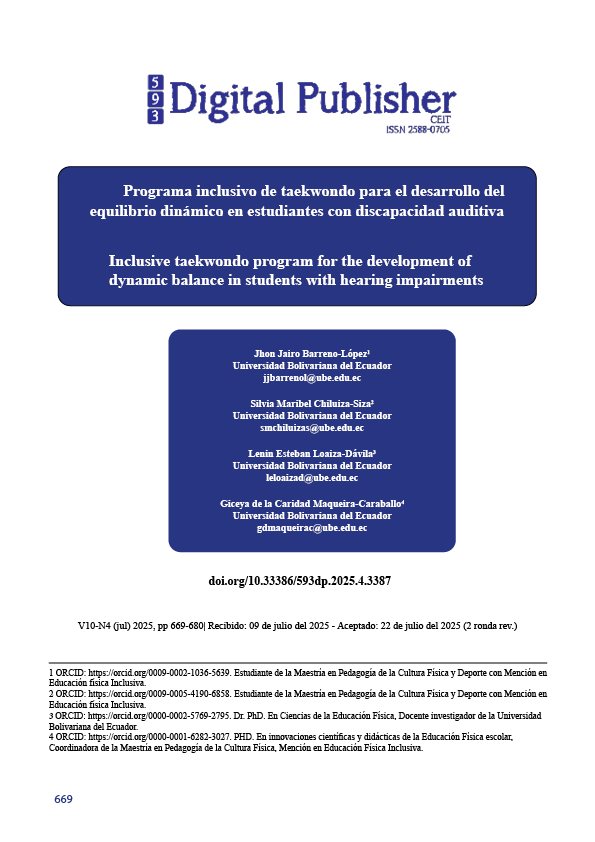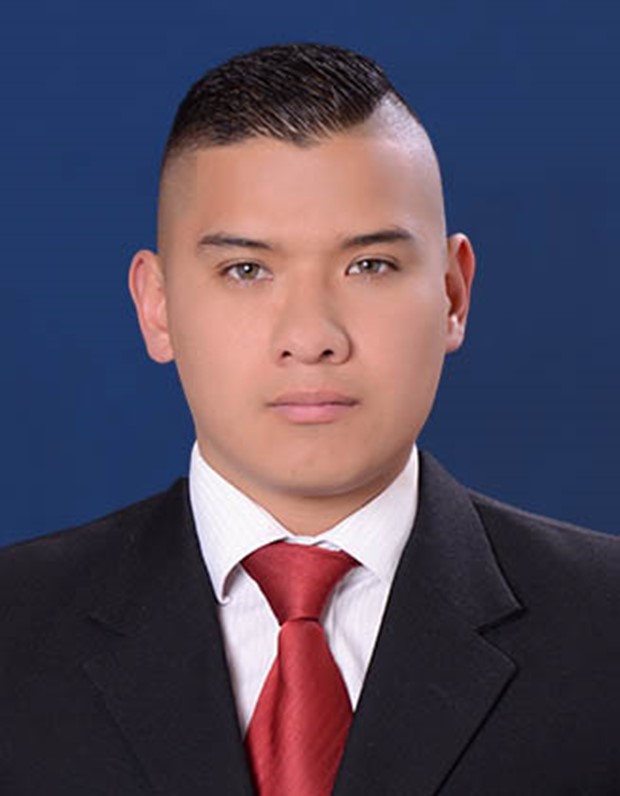Inclusive taekwondo program for the development of dynamic balance in students with hearing impairments
Main Article Content
Abstract
The objective of the study was to analyze the impact of an inclusive teaching program focused on basic taekwondo techniques on students’ dynamic balance, with particular attention to a female student with hearing impairment. A quantitative methodology was employed using a pre-experimental design, applying the Star Excursion Balance Test (SEBT) before and after the intervention. The sample consisted of 26 ninth-grade students, including one student diagnosed with bilateral sensorineural hearing loss. The intervention lasted eight weeks, with two sessions per week, and incorporated technical taekwondo exercises adapted through visual aids, physical modeling, cooperative work, and kinesthetic feedback. The results revealed statistically significant improvements in dynamic balance at both group and individual levels, especially for the student with hearing impairment, who exhibited a 20% functional improvement. Additionally, the program positively influenced group attitudes toward inclusion and enhanced social cohesion. It is concluded that taekwondo, when implemented through a structured and inclusive approach, not only improves motor performance but also fosters educational and social inclusion of students with sensory disabilities, underscoring the pedagogical value of adapted sports within school settings.
Downloads
Article Details

This work is licensed under a Creative Commons Attribution-NonCommercial-ShareAlike 4.0 International License.
1. Derechos de autor
Las obras que se publican en 593 Digital Publisher CEIT están sujetas a los siguientes términos:
1.1. 593 Digital Publisher CEIT, conserva los derechos patrimoniales (copyright) de las obras publicadas, favorece y permite la reutilización de las mismas bajo la licencia Licencia Creative Commons 4.0 de Reconocimiento-NoComercial-CompartirIgual 4.0, por lo cual se pueden copiar, usar, difundir, transmitir y exponer públicamente, siempre que:
1.1.a. Se cite la autoría y fuente original de su publicación (revista, editorial, URL).
1.1.b. No se usen para fines comerciales u onerosos.
1.1.c. Se mencione la existencia y especificaciones de esta licencia de uso.
References
Arief, K., Setiawan, F., Suhardi, C., & Fua’din, A. (2023). Aktivitas Fisik dalam Olahraga Taekwondo. Pubmedia Jurnal Pendidikan Olahraga. https://doi.org/10.47134/jpo.v1i2.231
Cular, D., Munivrana, G., & Katić, R. (2013). Anthropological analysis of taekwondo--new methodological approach. Collegium antropologicum, 37 Suppl 2, 9–18
Fong, S. S., Tsang, W. W., & Ng, G. Y. (2012). Taekwondo training improves sensory organization and balance control in children with developmental coordination disorder: a randomized controlled trial. Research in developmental disabilities, 33(1), 85–95. https://doi.org/10.1016/j.ridd.2011.08.023
Gaintza, Z., & Salgado, V. (2023). Uso de Instagram para la práctica de taekwondo por personas con discapacidad intelectual en el País Vasco, España (Use of Instagram for the practice of taekwondo by people with intellectual disabilities in the Basque Country, Spain). Retos. https://doi.org/10.47197/retos.v51.99319
Jian-Peng, D., Hang, L., Xiao-Ling, P., Chao-Ni, Z., Tian-Huai, Y., & Xian-Min, J. (2019). Research progress of quantum memory. Acta Physica Sinica. https://doi.org/10.7498/APS.68.20190039
Khrapylina, L., Stanevskiy, A., & Vinokurov, A. (2019). Development Mechanism for Higher Inclusive Education for Persons with Hearing Impaired. Psychological-Educational Studies. https://doi.org/10.17759/psyedu.2019110308
Kim, M., Baek, J., Yu, H., Ha, T., & Park, C. W. (2024). Kick It Up a Notch: Taekwondo Lesson for Students With Disabilities. Journal of Physical Education, Recreation & Dance, 95(6), 34–44. https://doi.org/10.1080/07303084.2024.2355875
Hamdan, Y. (2020). Effect of an educational program for taekwondo skills and visual memory For the hearing impaired., 014, 78-99. https://doi.org/10.21608/eijssa.2020.33393.1021
Hodge, S., & Arroyo-Rojas, F. (2024). Perspectives on Inclusion in Physical Education From Faculty and Students at Three Physical Education Teacher Education Programs in Chile. Journal of Teaching in Physical Education. https://doi.org/10.1123/jtpe.2023-0126
Imron, M., Wihandani, D., Utama, A., Astawa, P., Mahadewa, T., & Satriyasa, B. (2020). Penambahan core stability pada star excursion balance exercise lebih meningkatkan keseimbangan dinamis dan menurunkan fungsional ankle instabilitas daripada star excursion balance exercise pada bela diri taekwondo. Sport and Fitness Journal, 8, 164. https://doi.org/10.24843/SPJ.2020.V08.I03.P09
Ivanov, E., & Peltekova, I. (2022). Taekwondo as a means for motor and personal improvement of school-age children. Годишник на Педагогически факултет, Тракийски университет. https://doi.org/10.15547/ybfe.2022.10
Kim, Y.-J., Baek, S.-H., Park, J.-B., Choi, S.-H., Lee, J.-D., & Nam, S.-S. (2021). The Psychosocial Effects of Taekwondo Training: A Meta-Analysis. International Journal of Environmental Research and Public Health, 18(21), 11427. https://doi.org/10.3390/ijerph182111427
Metri, K. G., Raghuram, N., Narayan, M., Sravan, K., Sekar, S., Bhargav, H., Babu, N., Mohanty, S., & Revankar, R. (2023). Impact of workplace yoga on pain measures, mental health, sleep quality, and quality of life in female teachers with chronic musculoskeletal pain: A randomized controlled study. Work (Reading, Mass.), 76(2), 521–531. https://doi.org/10.3233/WOR-210269
Nariz, F. (2025). “Advancing Inclusive Physical Education, Fitness, and Wellness: Bridging Gaps for Students with Disabilities in Academic and Community Settings”. International Journal on Science and Technology. https://doi.org/10.71097/ijsat.v16.i2.3509
Núñez, R. (2020). La Práctica de los Fundamentos Básicos del Taekwondo Como un Agente en el Desarrollo Psicomotriz en los Estudiantes de Cuarto de Básica en la Asignatura de Educación Física (Ecuador). , 20-28
Pan, M., Shin, C., Bae, J., Seo, J., Lim, B., Jamrasi, P., Jiang, S., Li, X., Song, W., Sung, Y., & Ahn, S. (2024). Impact of Taekwondo training on cognitive and physical function in elderly individuals: A comprehensive review of randomized controlled trials.. Complementary therapies in clinical practice, 57, 101878 . https://doi.org/10.1016/j.ctcp.2024.101878
Pérez-Tejero, J., Barrera-Garcimartín, A., & Redondo-Fernández, Á. (2025). Factors influencing sport development among women with disabilities: a case study of a visually impaired Spanish Paralympic woman. Frontiers in Sports and Active Living, 6. https://doi.org/10.3389/fspor.2024.1518489
Rüther, J., Gesslein, M., & Düren, F. (2020). Taekwondo/Karate. Injury and Health Risk Management in Sports. https://doi.org/10.1007/978-3-662-60752-7_88
Semenova, G., Ryabov, G., & Tishkina, E. (2024). Influence of taekwondo classes on coordination abilities of 12-14 year-old adolescents. Current Issues of Sports Psychology and Pedagogy. https://doi.org/10.15826/spp.2024.4.121
Setiawan, F. R., Arief, K. L. A., Suhardi, C. D. A., & Fua’din, A. (2023). Aktivitas Fisik dalam Olahraga Taekwondo. Pubmedia Jurnal Pendidikan Olahraga, 1(2), 11. https://doi.org/10.47134/jpo.v1i2.231
Souissi, N., Jlid, M., Maffulli, N., Chelly, M., & Paillard, T. (2016). Pre-pubertal males practising Taekwondo exhibit favourable postural and neuromuscular performance. BMC Sports Science, Medicine and Rehabilitation, 8. https://doi.org/10.1186/s13102-016-0040-2
Taunton, J., Wu, N., Guan, Y., Jiang, Q., Bredin, S., & Warburton, D. (2023). Predicting the Risk of Injuries Through Assessments of Asymmetric Lower Limb Functional Performance: A Prospective Study of 415 Youth Taekwondo Athletes. Orthopaedic Journal of Sports Medicine, 11. https://doi.org/10.1177/23259671231185586.
Yılmaz, D. (2021). Content analysis of some doctoral thesis studies carried out in turkey on the branch of taekwondo in the field of sports sciences. European Journal of Physical Education and Sport Science. https://doi.org/10.46827/ejpe.v7i4.4010





